Is it possible to create a gym in a shed in the garden? And what do you have to think about? That’s what I asked myself a few days ago. A shed in the garden would free up a good space in the house which would be interesting. I’ve done a lot of digging into what is necessary to do this and here are the key points you should know.
Building a home gym in a garden shed is possible and not too difficult. If your shed measures at least 10′ x 10′ and is 8′ tall, it’s possible to build a home gym. There are some things to keep in mind like flooring, legality, layout, and ventilation/heating to make it a pleasant gym to use.
There are a few things you need to know to be able to turn your shed into a gym you’ll want to use. Keep reading to find out what they are and how you can make your garden gym something you’ll want to use often.
Contents
Can a Garden Shed Be a Gym?
Absolutely it can. A gym is just a place to work out in. A ‘real’ gym has a lot of equipment and some amenities to make things comfortable but as long as you can do whatever workout you want to do, it can be your gym.
A garden shed can be turned into a gym provided it has enough floor space and ceiling height to accommodate all the equipment and movement you want.
Gyms and garden structures both come in a lot of varieties. Having clear expectations for your gym and picking the right structure that fits those expectations is going to result in the gym you want.
A gym doesn’t need to have a shower, juice bar, sauna, and sound like a nightclub to be a gym. The most important thing about a gym is that you can get your workout done there. All the other things are just fluff to get more money out of your pocket. A good place to work out is worth more (to me) than the sauna and music.
People do different types of workouts. That’s why a commercial gym needs a whole lot of machines. Some of which you probably never touch. To get a good workout at home or in your shed, you don’t need 40 different machines. A few well-chosen pieces of equipment can provide everything you need for your type of workout.
Considerations For Turning Sheds Into Gyms
Below I’ve listed a few things that are important when thinking about building a gym in your shed. Whether you already have a shed ready or you’re planning on building one, you can use the points below to decide if you can use your existing shed or what your new shed will look like.
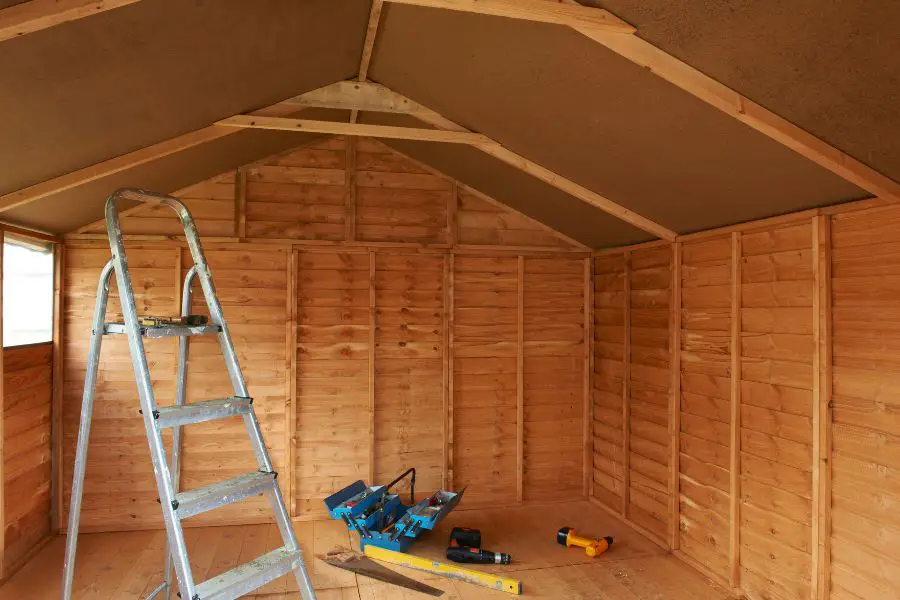
1. Floor
When you’re setting up a garden gym, especially if it includes heavy weightlifting equipment, a sturdy foundation is essential. The choice of foundation depends on the equipment you plan to use. Here’s a closer look:
1. Concrete Slab: For serious weightlifting and heavy gym gear, a concrete slab offers the best foundation. It’s durable, stable, and capable of supporting significant loads. However, keep in mind that installing a concrete floor requires a flat surface and often the expertise of a professional. This ensures that your gym shed can handle all the weight you throw at it.
2. Braced Wooden Floor: If your gym primarily features lighter weights and cardio equipment, a braced wooden floor might suffice. Most shed floors consist of wooden planks on a wooden frame, and the frame’s beams can generally support substantial weight. An 8-foot 2×4, for instance, can handle up to 1000 pounds before breaking. However, there are a couple of potential issues to watch out for. Weight distribution might not always be even, and dropping a heavy weight between two joists could damage the floor.
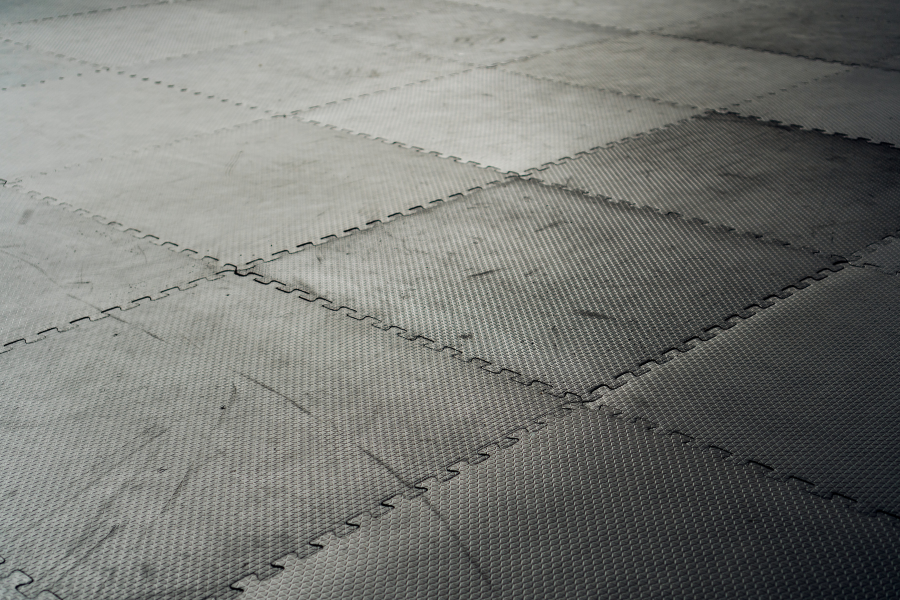
Regardless of your choice, it’s a wise move to lay down gym flooring on top. Gym flooring, typically made of firm foam or rubber and ranging from 3/16 to 1-inch thickness, offers multiple benefits. It protects the underlying floor, reduces noise, and ensures that the weight load is evenly distributed, enhancing safety for your gym shed’s foundation.
Click here to find my recommended gym flooring
2. Ceiling height
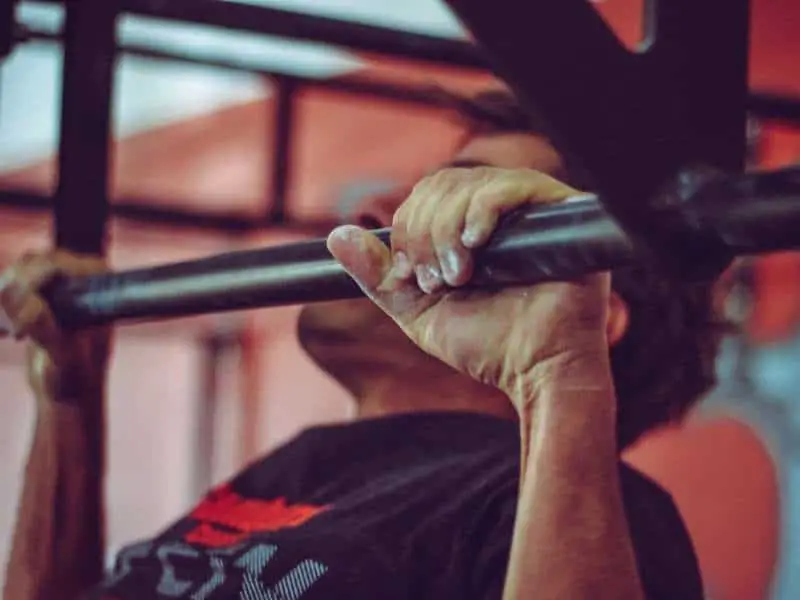
Let’s talk about the often underestimated factor of ceiling height in your garden gym. Many garden structures have relatively low ceilings, which can pose challenges when using tall equipment or lifting weights overhead. At a minimum, you’d want a 7-foot ceiling, but even then, some adjustments in your workout routines might be necessary.
Now for the good and not-so-good news about ceiling heights. First, the less favorable part: to perform a wide range of exercises, including overhead presses and pull-ups, your shed’s ceiling must be quite high. Typically, this means taller than what most standard garden house designs or pre-built packages offer.
The silver lining is that if your shed isn’t built yet, you can still tweak your plans. But how high should your gym shed’s ceiling be? For an average-sized adult male, a ceiling height of 9 feet is adequate to accommodate all exercises, including overhead pressing and pull-ups. I’ve penned an entire article discussing why 9 feet is the sweet spot for gym ceilings. With this height, you can replicate what you’d do in a commercial gym.
However, if pull-ups and overhead pressing aren’t your top priorities, and cardio workouts take precedence, you might manage with 7’5-foot-tall ceilings. Keep in mind that the part of a treadmill you walk on generally sits about 8 to 9 inches off the ground. Adding an average person’s height of 5 feet 9 inches brings you to 6 feet 5 inches. This means that, with just 7-foot ceilings, your head might graze the ceiling while you’re on the treadmill.
To exercise comfortably and without the constant fear of bumping your head, a bit of extra ceiling height wouldn’t hurt. It’s pretty uncomfortable to worry about hitting your head during an intense workout.
Now, the reality check: most pre-fab sheds come with ceilings that barely reach 7 feet. So, when you’re in the market for a garden gym, ensure you pick one with a ceiling height that suits your workout ambitions.
The silver lining is that many sheds feature an A-frame roof design. With this layout, the central section offers a bit more headroom than the walls. This can work to your advantage when planning your gym layout since you can get away with slightly lower walls and still enjoy enough room to exercise comfortably.
Here are my 13 favorite tips for working out under a low ceiling.
3. Legality
Before you start building your garden gym, it’s important to understand the legal aspects in your area. I can’t provide a one-size-fits-all answer because regulations vary widely. Laws differ not only between countries but also within regions, states, provinces, and even cities and counties.
These regulations cover aspects like the size, height, and appearance of structures in your garden. Some places have specific rules for structures near property lines or those attached to a house. To avoid future problems, it’s best to research and comply with the rules in your area.
4. Equipment and layout
Since you’re probably not going to build a huge second house in your garden, your space will be a little limited. Above I’ve already mentioned that to create a basic gym, you’d want a space of at least 8’ x 10’. 10’x10’ makes things a bit more comfortable although it’s still not huge of course.
That means you can build a decently complete gym although not to a commercial gym level. There’s a floor plan below that visualizes what kind of gym you can build in a 10’ by 10’ garden shed.
Here’s what kind of equipment you can fit in a shed of 10’ by 10’ and be able to use everything as intended.
- Power rack (Find my favorite home gym power rack here)
- Barbell
- Weights
- Bench
- Dumbbells and rack (Here are my picks for the best home gym dumbbells)
- Treadmill
The treadmill can be exchanged for another cardio machine you prefer. This gym is mostly focused on weightlifting with free weights. If you prefer another type of workout, you could change the power rack to an all-in-one home gym machine.
Floor plan
Here is an example floor plan for a shed gym that measures 10’ by 10’. As you can see you can fit most things you need for a good workout. It’s not equipped to a commercial gym level but you can be sure that you can build a good body in this gym. The ceiling height used is 8’.
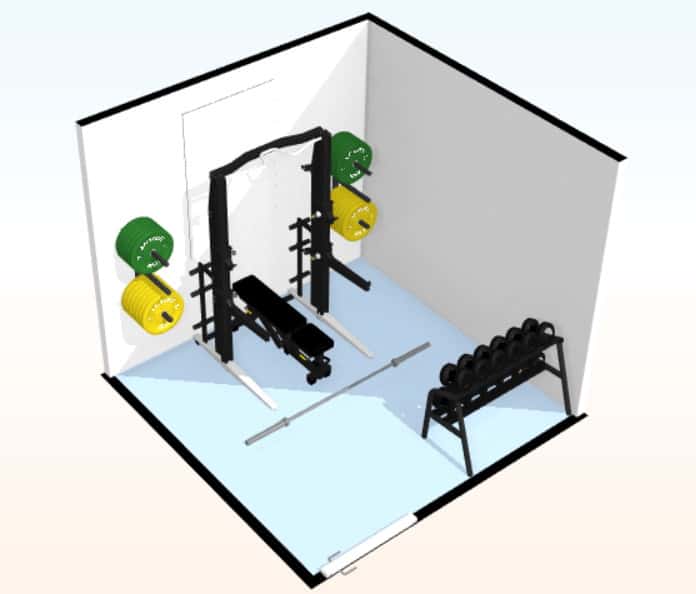
5. Comfort
You want a better and healthier body. That means you have to go to the gym. If your gym is uncomfortable to work out in you will go less often and that has as a result you won’t get the body you like.
Creating a comfortable garden gym is key to staying motivated and reaching your fitness goals. Plan ahead for ventilation, heating, insulation, and lighting to ensure your gym is inviting and usable year-round.
Sheds can quickly become unbearably hot in the sun or freezing cold in winter. You don’t want the weather to hinder your workouts. Additionally, well-thought-out lighting allows you to exercise whenever you please, even after dark.
To improve your garden gym’s comfort, consider these steps:
- Insulation: Enhance the insulation in the walls and roof to regulate temperature.
- Ventilation: Ensure proper ventilation options to keep the air fresh during workouts.
- Power Source: Set up a power source for lights, a fan, or a space heater. Lights and fans can run on a battery source, but a space heater requires more power.
Suggested post: Home gym lighting
With just a few changes, you can make your garden shed gym much more comfortable to work out in and make sure there are no excuses for not using it. No excuses means more workout sessions and that will help you reach your goals.
6. Gym Shed Size
Sheds come in many shapes and sizes and can be many different things. There is no reason why a shed couldn’t be a gym, provided it is big and strong enough to house everything you need and actually do the exercises you want. Sure, a 2’x2’ shed that just holds your tools isn’t going to work. But what is?
First things first. Your garden house has to be big enough to fit all your equipment and be able to use it with some comfort. Ok, that’s obvious but what does that mean in practice?
I’ve written a whole post about how much space you need for a weightlifting gym. As you can see in that post, I’ve advised a space of 8’ x 8’ (244cm x 244cm) as a minimum amount of space to be able to lift weights. That gym includes;
- Power rack
- Bench
- Barbell
- Weights
- Dumbbells
- Space to deadlift/stretch/other
If you want to have a little bit more room for activities and maybe add a recumbent bike for cardio, a space of 8’ x 10’ (244cm x 305 cm) would be better.
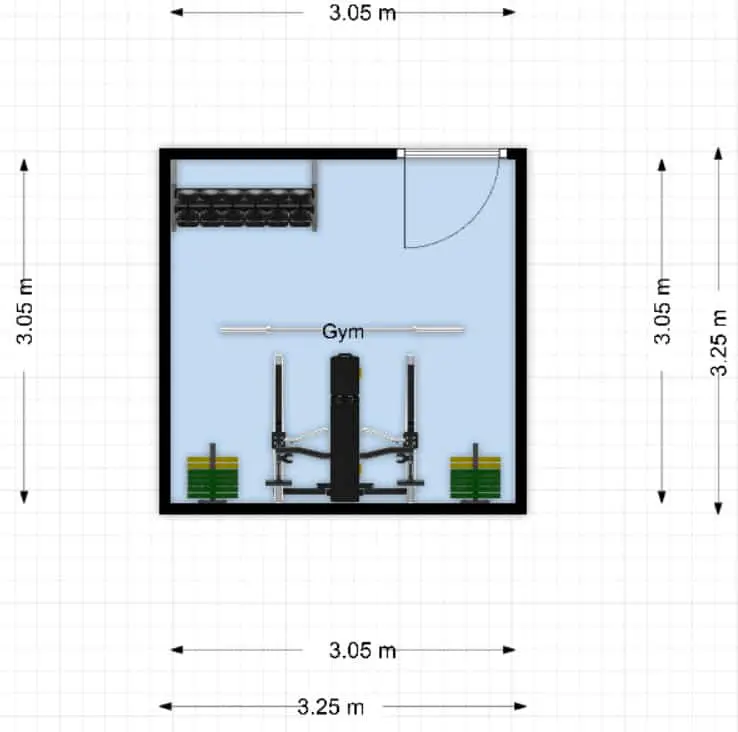
Now what if you want to add a treadmill? Treadmills are quite large so you might think you’d need a lot of extra space to add it to your garden gym. Luckily, many treadmills for home use have a fold-away deck. That means the part you walk on can flip up, meaning you don’t use the floor space when not using the treadmill. It still takes up some space, however.
Click here to find my post on which size shed is best for your gym setup.
Since you won’t be doing anything else while using the treadmill, you can use the empty floor space you’d otherwise use for stretching/deadlifting/etc. Once you’re done, fold up the treadmill deck and you have space to do other things.
A shed or fancier garden structure that measures 10′ x 10′ will be big enough to house a full weightlifting setup and enough space to properly use that equipment. For cardio equipment only, a 5′ by 8′ structure is sufficient.
Related questions
What’s the best shed material for a garden gym?
Wood is the best option for a shed that is going to be a gym. Wood makes a cabin a bit more comfortable and livable in hot and cold weather. A metal shed gets very hot when the sun hits it and the walls might be dangerous to touch when it’s cold. Resin sheds are usually too small to build a gym in.

